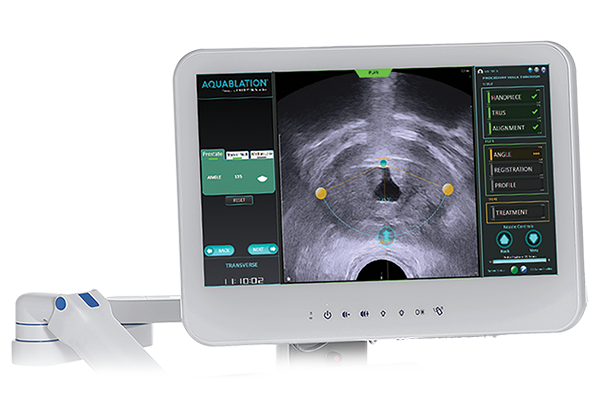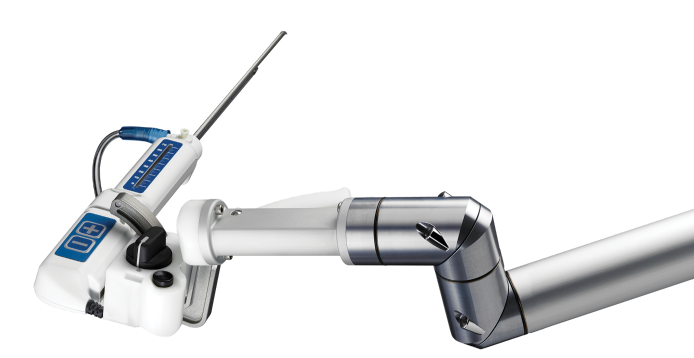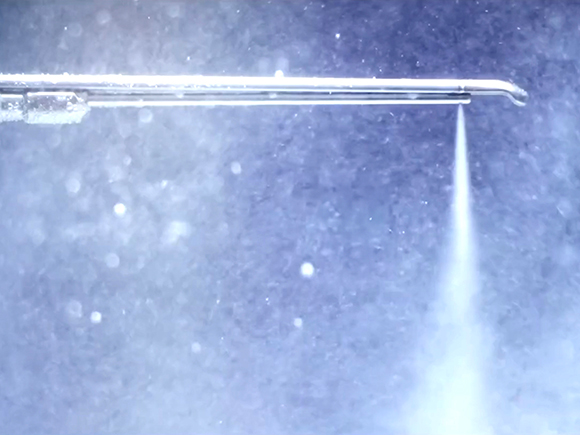
Understanding Your Treatment Options
Surveys Show: Men Want The Results They Deserve From BPH Treatment1
of men with BPH are not willing to sacrifice sexual function for relief with surgery
of men with BPH are concerned that surgery will cause incontinence
of men with BPH say maintaining erectile function after surgery is important
AQUABLATION THERAPY—
DISCOVER WHAT’S POSSIBLE
Other treatment options may require men to compromise, leaving them with limited relief, a long recovery time, or unwanted side effects.
Aquablation therapy is the only real-time, ultrasound-guided, robotic-assisted, heat-free waterjet for the treatment of BPH.2,3 Using a heat-free waterjet controlled by robotic-assisted technology, this one-of-a-kind procedure can be performed on prostates of any shape and size to deliver durable, long-lasting relief with low rates of irreversible side effects.
Aquablation therapy provides a real-time, ultrasound-guided view of the prostate during the procedure so surgeons can:
- Personalize the treatment plan to your anatomy
- Resect problematic tissue with robotic-assisted precision
- Protect important tissue to preserve sexual function and continence
AQUABLATION THERAPY: PROVEN RESULTS IN CLINICAL STUDIES1-4
of men preserved erectile function
of men with BPH preserved ejaculatory function with Aquablation therapy
of men with BPH did not have incontinence after Aquablation therapy
of men did not require additional treatment with medications or surgery 5 years after Aquablation therapy
WHY CHOOSE AQUABLATION THERAPY?
There are numerous surgical treatment options for BPH. Aquablation therapy is a different kind of procedure, and there are many reasons that it may be right for you.
Low rates of irreversible complications
In clinical studies, men who had Aquablation therapy had very low rates of irreversible complications (incontinence, ejaculatory dysfunction, erectile dysfunction).2,3
Confidence in procedure
Aquablation therapy is the only procedure that resects prostate tissue with a robotically controlled waterjet, designed to minimize human error.
Long-term relief
In clinical studies, Aquablation therapy has been shown to provide long-term relief at 5 years.2
Exceptional results vs TURP
When compared with transurethral resection of the prostate (TURP), Aquablation therapy demonstrated5:
- Significant symptom relief
- Lower complication rate
- Fewer retreatments
Exceptional efficacy
Aquablation therapy patients on average experienced2,4:
- 16-point improvement in International Prostate Symptom Score
- 3.3-point improvement in quality of life
- 2x improvement in urinary flow rate
Backed by Robust Clinical Data
Aquablation therapy has been clinically validated for safety, efficacy, and durability for prostates of all shapes and sizes in more than 200 clinical publications, including two prospective FDA studies with results spanning 5 years.
THE SYSTEM THAT POWERS AQUABLATION THERAPY

Ultrasound Imaging
Aquablation therapy is the only procedure that uses ultrasound imaging in combination with a camera called a cystoscope to view the prostate. This allows the surgeon to see the entire prostate and make a highly personalized treatment plan of which areas of the prostate to resect and which to avoid.
In traditional surgical procedures for BPH, the surgeon’s view of the prostate is limited to a single camera. This limits the surgeon’s ability to see the parts of the prostate that control erectile function, ejaculatory function, and continence.

Robotic-assisted Execution
Aquablation therapy is completed with robotic-assisted execution, which enables the surgeon to deliver predictable tissue resection no matter the size of the prostate.

Heat-free Waterjet Technology
Aquablation therapy is the only procedure that uses a heat-free waterjet to resect prostate tissue. Most procedures that resect prostate tissue utilize heat. However, heat may be damaging to the parts of the prostate that control erectile function and ejaculatory function.6,7
It should be noted that surgeons may use a minimal amount of cautery following an Aquablation therapy procedure to control bleeding.
OTHER BPH TREATMENT OPTIONS
There are a wide variety of medications and surgical treatment options designed to provide relief from BPH. Unfortunately, they often force men to compromise.
There are generally 3 categories of treatment:
Watchful waiting
If a patient determines that his BPH symptoms are not bad enough to start treatment, he can choose watchful waiting.
This means that before considering any medical treatment, the doctor and patient wait to see if symptoms get worse or new symptoms develop. For most men, their prostates will continue to grow and their symptoms will worsen.
A patient should consider visiting a doctor every year to determine if his symptoms are changing.
BPH medications
Medications are often the first step in treating BPH. They are prescribed by your doctor to address your symptoms by either shrinking (5-alpha reductase inhibitors) or relaxing (alpha-blockers) the prostate. In some instances, patients may be prescribed a combination of both medications.
While BPH medications can provide relief for some men, they often force them to compromise between symptom relief and associated side effects, such as dizziness, headache, fatigue, less libido, erectile dysfunction, and ejaculatory dysfunction.8
For some men, medications may result in a frustrating cycle in which the medication stops working and they try a second medication. This second medication may also stop working, and they may need to consider an alternative treatment.
Ultimately, studies show that medications fail in up to 30% of men.8
Surgery for BPH
Surgery is a more invasive and perhaps longer-lasting treatment for BPH. There are 2 types of surgical treatments:
Non-resective prostate surgery
In non-resective procedures, prostate tissue is not resected at the time of surgery. These procedures generally do not require an overnight stay in a hospital and may sometimes be done outside of the hospital.
However, by not resecting the prostate tissue, there is a risk that a patient will need to go back on medication or get another procedure because the prostate will keep growing.9
Resective prostate surgery
In resective procedures, some or most of the prostate tissue is resected during the procedure, so they are generally longer-lasting than non-resective procedures.9
Minimally invasive resective procedures access the prostate through the urethra without additional incisions. Open or laparoscopic surgery are resective procedures that require one or more incisions in the abdomen to access the prostate.
These procedures are generally done in a hospital or surgery center, and patients may be discharged the same day or stay over one or more nights.
WHICH BPH SURGICAL OPTION IS RIGHT FOR YOU?
Deciding which surgery to have to treat your BPH can be overwhelming. Discussing the following topics with your doctor can help you decide on a surgical treatment option.
- Risk of irreversible complications
- Your doctor’s confidence in the procedure
- How long symptom relief may last
All surgical procedures have a risk of complications, and these should be discussed with your doctor.
of men with BPH feel that surgery requires a trade-off between symptom relief and side effects1
men with BPH did not realize how important maintaining ejaculatory function was to them before surgery1
of men with BPH wished their doctors would have discussed Aquablation therapy with them1
SURGICAL OPTIONS FOR AN ENLARGED PROSTATE
There are numerous surgical options available. Side effects from surgery are among the most important considerations when choosing what type of surgery to have,1 so it is important to research and determine which procedure is best for your current condition and lifestyle. Below is a list of common BPH treatment options.*
There are two types of surgical treatments for BPH. Non-resective procedures, which do not remove prostate tissue at the time of surgery, and resective procedures, which remove some or most of the prostate during surgery and may offer longer-lasting results compared with non-resective procedures.
Aquablation Therapy
Surgical Procedure Type
Resective
How It Works
- Uses a camera through the urethra plus ultrasound imaging
- Surgeon creates map of prostate tissue to resect
- Heat-free waterjet resects prostate tissue
Rates of Irreversible Complications
In clinical studies, Aquablation therapy demonstrated:
- Low rates of irreversible complications
- <1% rate of erectile dysfunction1,2
- 1% rate of incontinence1,2
- ~89% of men preserve ejaculatory function1,2
- Superior safety compared with TURP2
- Superior efficacy to TURP in prostates larger than 50-80 g2
Procedure
- Robotic-assisted tissue resection
- No limit to prostate size
Recovery
- Patients may be discharged from the hospital same day or the next day
- Patients may go home with a catheter
References:
- Gilling PJ, et al. Can J Urol. 2022.
- Bhojani N, et al. J Urol. 2023.
TURP
Surgical Procedure Type
Resective
How It Works
- Uses a camera through the urethra
- A heated wire cuts out prostate tissue
Rates of Irreversible Complications
- Higher rates of irreversible complications compared with Aquablation therapy1,2
Procedure
- Not suitable for every prostate size
Recovery
- Most patients discharged from the hospital the same or next day
- Most patients go home without a catheter
References:
- Leong JY, et al. Curr Sex Health Rep. 2019.
- Comiter CV, et al. UpToDate. 2020.
Laser Treatment
Surgical Procedure Type
Resective
How It Works
- Uses a camera through the urethra
- A laser is used to remove prostate tissue
Rates of Irreversible Complications
- High rates of irreversible complications1
Procedure
- Manual procedure
Recovery
- Most patients discharged from the hospital the same or next day
- Most patients go home with a catheter
Reference:
- Leong JY, et al. Curr Sex Health Rep. 2019.
Simple Prostatectomy
Surgical Procedure Type
Resective
How It Works
- An incision is made in the abdomen to access the prostate
- The entire prostate is resected
Rates of Irreversible Complications
- Higher rates of irreversible complications compared with Aquablation therapy1,2
Procedure
- Manual or robotic-assisted resection – outcomes dependent on surgeon skill level
Recovery
- Patients stay in the hospital for an average of 5.4 days3
References:
- Khera M, et al. Simple Prostatectomy. Medscape. 2023.
- Comiter CV, et al. UpToDate. 2020.
- Pariser JJ, et al. Urology. 2015.
Non-Resective Surgical Procedures
Surgical Procedure Type
Non-resective
How They Work
- Uses a camera through the urethra
- Prostatic urethral lift treatment implants inserted to hold prostate tissue out of the way of the urethra
- Water vapor treatment uses hot water vapor (or steam) to kill overgrown prostate tissue
Rates of Irreversible Complications
- Low rates of irreversible complications1-3
Procedures
- Manual procedures
- Not suitable for every prostate size3,4
Recovery
- Most patients go home the same day1,2
References:
- Sønksen J, et al. Eur Urol. 2015.
- Westwood J, et al. Ther Adv Urol. 2018.
- Rezūm Delivery Device Kit for BPH Prescriptive Information. Instructions for Use. 2019.
- UroLIFT System UL 400. Instructions for Use. 2020.
*This is not an exhaustive list of surgical options for the treatment of BPH.
References:
- Data on file, PROCEPT BioRobotics.
- Gilling PJ, et al. Can J Urol. 2022.
- Bhojani N, et al. J Urol. 2023.
- Elterman D, et al. BMJ Surg Interv Health Technol. 2021.
- Oumedjbeur K, et al. Can J Urol. 2023.
- Malek et al. J Urol. 2011.
- Bruyère F, et al. J Endourol. 2013.
- Kaplan SA, et al. Rev Urol. 2005.
- Urology Care Foundation.Benign Prostatic Hyperplasia (BPH). 2023.